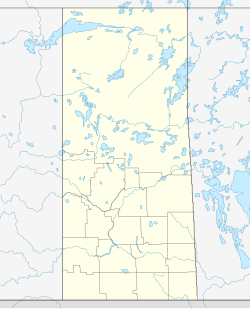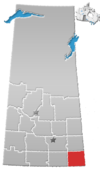|
Frobisher, Saskatchewan
Frobisher (2016 population: 160) is a village in the Canadian province of Saskatchewan within the Rural Municipality of Coalfields No. 4 and Census Division No. 1. It has an elevation of 576 metres (1,890 ft) above sea level. Frobisher is located along Highway 18, in the heart of south-east Saskatchewan's oil patch. Many pumpjacks and oil batteries are found in the area. Within the village, there are oil field related businesses, a post office,[5] a restaurant/convenience store, and Frobisher United Church.[6] HistoryFrobisher was originally known as Frobyshire[7] but due to an error in the original village plans, it had to be renamed. In 1903, there were four grain elevators, each with a capacity of 25,000 bushels, one of which still stands. Frobisher was built at the cross-roads of two rail lines, the Canadian Pacific Railway Souris Line and the Grand Trunk Regina-Boundary Branch Line.[8] The Grand Trunk line was a Canadian National Railway line, which is now gone as CN had issued a notice of discontinuance for the section which went from Northgate to Lampman on 16 October 2007.[9] Frobisher was incorporated as a village on July 4, 1904.[10] Parks and recreationThe closest park to Frobisher is Moose Creek Regional Park,[11] 27 kilometres east. The park is located along the east side of Grant Devine Reservoir.Frobisher has an ice rink, the Frobisher Flyers were among the four founding teams of the Big 6 Hockey League.[12] The Flyers never won a championship. DemographicsIn the 2021 Census of Population conducted by Statistics Canada, Frobisher had a population of 127 living in 54 of its 71 total private dwellings, a change of -20.6% from its 2016 population of 160. With a land area of 1.43 km2 (0.55 sq mi), it had a population density of 88.8/km2 (230.0/sq mi) in 2021.[15] In the 2016 Census of Population, the Village of Frobisher recorded a population of 160 living in 65 of its 88 total private dwellings, a -3.8% change from its 2011 population of 166. With a land area of 1.35 km2 (0.52 sq mi), it had a population density of 118.5/km2 (307.0/sq mi) in 2016.[16] See alsoReferences
External links
|
||||||||||||||||||||||||||||||||||||||||||||||||||||||||||



